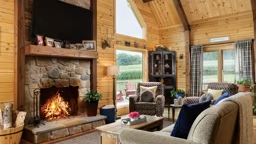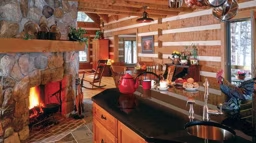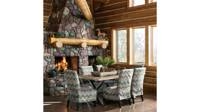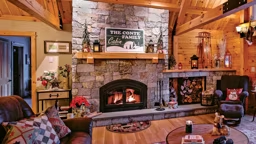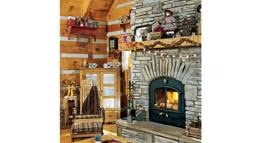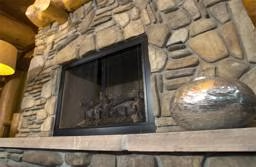By following these guidelines, you can create a fabulous and efficient fireplace that gives you much enjoyment and warmth for years to come.
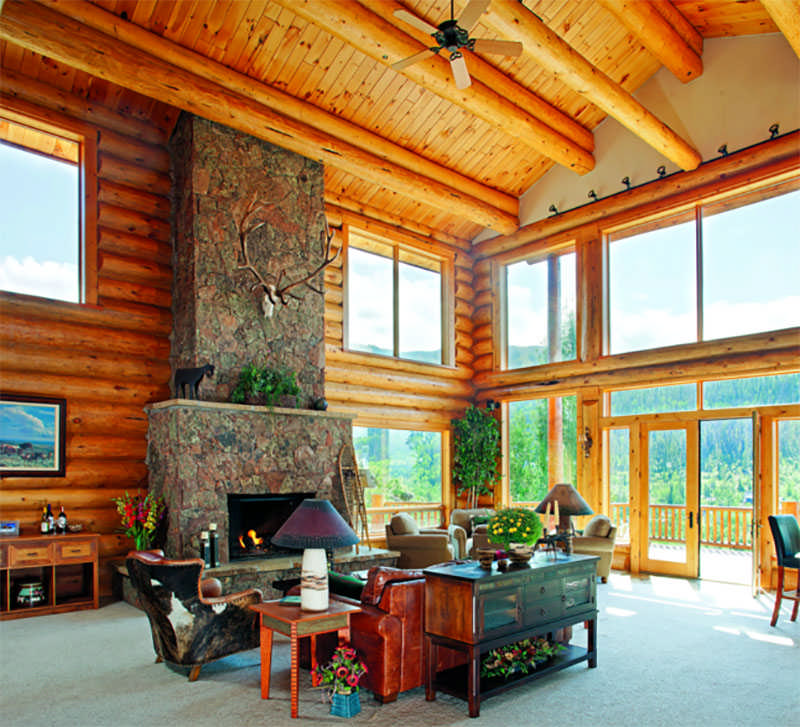
Whether it is a grand masonry fireplace stretching high through a cathedral ceiling or a small gas fireplace tucked into a corner, your hearth will no doubt be a focal point of your log home. But a hearth is more than just a place to light a fire. The first question must always be: What kind of heat source should I choose? The answer depends on how you want to use your hearth. If you want an open, crackling blaze and don't mind the effort of cutting or buying firewood then you'll do fine with a wood-burning fireplace. If you'd rather just flick a switch for instant gratification, go for gas. On the other hand, if your main goal is to create an efficient heat source for your home, then a wood or pellet stove may suit you best. Or consider a masonry heater.
Pretty vs. Practical
Although an open fire is very inviting, it consumes considerable fuel as well as oxygen from your room. With a sealed fire, you burn less fuel, but you also lose the sound effects and visual impact of a roaring fire. In fact, with many wood-burning stoves, you can't even see the flames. If you do opt for a covered flame, ceramic glass doors radiate considerably more heat than tempered glass doors.
Heat Things Up
With an open fire, most of the heat goes up the chimney. Well-designed fireplaces and stoves have air spaces around the combustion chamber to pick up heat and transport it to the room through convection. Some units also have ducts that direct the heat into other rooms. Otherwise, a large ceiling fan can drive rising warm air into other rooms.
Efficiency Counts
Most factory-built fireplaces and stoves come with an efficiency rating. As a general rule for open-burning fireplaces, the larger the firebox, the lower the efficiency. Gas fireplaces can be very efficient, but select a unit that lets you control the flame from flicker to full-burn.
Money to Burn
The expense of a fireplace often comes down to the enclosures and stonework. Backing two units against each other can reduce the cost of both. Sometimes two rooms can even share one fireplace. Several zero-clearance fireplaces are open on two sides, creating a divider between two areas.
Room with a View
I've seen many scenic views compromised by placing an imposing fireplace right in the middle of the vista. Consider locating your hearth to the side of the view. During the day, you can focus on the scene outside. At night, you can face the fire.
Let's Face It
While the fire is likely the reason you want a hearth in the first place, the surrounding materials have much greater architectural impact. Stone is a great option for log homes and there are hundreds of varieties, colors and textures to consider. Even with a freestanding stove, attractive stonework will protect surfaces and radiate heat.
New Heights
For gas fireplaces, keep the hearth flush with the floor. For wood-burning fireplaces, I recommend raising the firebox to offer a better view. And make sure your hearth extends far enough to contain errant ashes and wood splinters.
Smart Storage
Work convenient wood storage into your plan from the beginning. For wood-burning fireplaces, I prefer to recess a storage area into the stonework next to the firebox. Line it with a durable material such as slate or concrete. Or build two areas one for large firewood and one for kindling and paper.
Inner Workings
Some of the most striking hearths use niches and built-ins to add both vertical and horizontal interest to their enclosures. For example, you can create shelves or recesses for displays of art, memorabilia or books. You might even line recesses with an accent material such as a different type of stone.
 Whether it is a grand masonry fireplace stretching high through a cathedral ceiling or a small gas fireplace tucked into a corner, your hearth will no doubt be a focal point of your log home. But a hearth is more than just a place to light a fire. The first question must always be: What kind of heat source should I choose? The answer depends on how you want to use your hearth. If you want an open, crackling blaze and don't mind the effort of cutting or buying firewood then you'll do fine with a wood-burning fireplace. If you'd rather just flick a switch for instant gratification, go for gas. On the other hand, if your main goal is to create an efficient heat source for your home, then a wood or pellet stove may suit you best. Or consider a masonry heater.
Whether it is a grand masonry fireplace stretching high through a cathedral ceiling or a small gas fireplace tucked into a corner, your hearth will no doubt be a focal point of your log home. But a hearth is more than just a place to light a fire. The first question must always be: What kind of heat source should I choose? The answer depends on how you want to use your hearth. If you want an open, crackling blaze and don't mind the effort of cutting or buying firewood then you'll do fine with a wood-burning fireplace. If you'd rather just flick a switch for instant gratification, go for gas. On the other hand, if your main goal is to create an efficient heat source for your home, then a wood or pellet stove may suit you best. Or consider a masonry heater.




